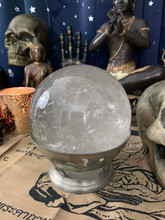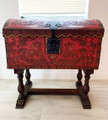 Loading... Please wait...
Loading... Please wait...5" Pietro d'Abano Heptameron Quartz Crystal Sphere with Zeister Holland Pewter Stand - An 1888 LiDiex Suite Find - The Voodoo Estate - SOLD! -
Sorry but this item is currently unavailable.
Please check back at a later stage.
Product Description

The Voodoo Estate!
This type of call usually gets us excited as they are a treasure trove. Located here in Florida, there was no electricity or running water so we rigged our own lighting and in we went. If you have ever seen the Adams Family you will have some idea as to what we were greeted with! Then the attorney handling the liquidation gave us some background.
Our research has shown that this woman was what she claimed and was indeed descended from a long line of well known Vodoun family originating in New Orleans in the early 1800's. We were somewhat unnerved by this until we discovered they were also devout Catholics! Although I have to admit this was unlike any Catholic home we have ever been in and some of the items found inside were a little more than disturbing.
This is one of a few lots from this estate we will be listing this week, so check our other items.
Some Back Story
This is one of seven quartz crystal spheres that were found felt wrapped in an unusual multi-drawer cabinet in the suite of the 1888 LiDiex. This sealed suite, was the north wing suite that shielded the Black Pyramid Vèvè Room (see our other listings ). The spheres are alleged to be the seven "Heptameron Angelic Vision Spheres of Pietro d'Abano."

Both their journals claim his ability to heal wounds, shape shift, travel through time and space, telepath and create life with the power of his thought. They also corroborate the sharing of identities with a number of other LiDiex, "being a master of disguise and misdirection, often with his mere thought" according to these entries. This gave these men the ability to appear two places at once, an old family ploy that was apparently often used by their Mistress.
It is this LiDiex who is attributed with making her introduction to Alexandra David Neel and his journals tell of numerous meetings and short adventures with her. Claiming at the age of twenty four to have met Neel for the second time in the company of Prince Sidkeong of Sikkim and of being her teacher of the Tibetan language having already spent six years with the Great Hermit as apprentice.
Much is already written on these subjects, so there is no need to elaborate here in this already overly long text, but we wholeheartedly recommend a cursory search for some very interesting reading.
~!~
The Heptameron Angelic Vision Spheres of Pietro d'Abano

Pietro d'Abano
From Wikipedia, the free encyclopedia, for the most part...Pietro d'Abano, also known as Petrus de Apono, Petrus Aponensis or Peter of Abano (c.?1257 – 1316), was an Italian philosopher, astrologer, and professor of medicine in Padua. He was born in the Italian town from which he takes his name, now Abano Terme. He gained fame by writing Conciliator Differentiarum, quae inter Philosophos et Medicos Versantur. He was eventually accused of heresy and atheism, and came before the Inquisition. He died in prison in 1315 (some sources say 1316) before the end of his trial.
Biography
He lived in Greece for a period of time before he moved and commenced his studies for a long time at Constantinople (between 1270 and 1290). Around 1300 he moved to Paris, where he was promoted to the degrees of doctor in philosophy and medicine, in the practice of which he was very successful, but his fees were remarkably high. In Paris he became known as "the Great Lombard." He settled at Padua, where he gained a reputation as a physician.
In Padua he befriended an older scholar Paolo Tosetti. Also an astrologer, he was charged with practicing magic: the particular accusations being that he brought back into his purse, by the aid of the devil, all the money he paid away, and that he possessed the philosopher's stone.
Gabriel Naudé, in his Antiquitate Scholae Medicae Parisiensis, gives the following account of him:
Let us next produce Peter de Apona, or Peter de Abano, called the Reconciler, on account of the famous book which he published during his residence in your university. It is certain that physic lay buried in Italy, scarce known to any one, uncultivated and unadorned, till its tutelar genius, a villager of Apona, destined to free Italy from its barbarism and ignorance, as Camillus once freed Rome from the siege of the Gauls, made diligent enquiry in what part of the world polite literature was most happily cultivated, philosophy most subtilly handled, and physic taught with the greatest solidity and purity; and being assured that Paris alone laid claim to this honour, thither he presently flies; giving himself up wholly to her tutelage, he applied himself diligently to the mysteries of philosophy and medicine; obtained a degree and the laurel in both; and afterwards taught them both with great applause: and after a stay of many years, loaden with the wealth acquired among you, and, after having become the most famous philosopher, astrologer, physician, and mathematician of his time, returns to his own country, where, in the opinion of the judicious Scardeon, he was the first restorer of true philosophy and physic. Gratitude, therefore, calls upon you to acknowledge your obligations due to Michæl Angelus Blondus, a physician of Rome, who in the last century undertaking to publish the Conciliationes Physiognomicæ of your Aponensian doctor, and finding they had been composed at Paris, and in your university, chose to publish them in the name, and under the patronage, of your society.
He carried his enquiries so far into the occult sciences of abstruse and hidden nature, that, after having given most ample proofs, by his writings concerning physiognomy, geomancy, and palmistry, he moved on to the study of philosophy, physics, and astrology. These studies proved extremely advantageous to him. The first two led to his introduction to all the popes of his time and gained him a reputation among scholars. Beyond that, his mastery of astrology is shown by the astronomical figures he had painted in the great hall of the palace at Padua, his translations of the books of the great learned rabbi Abraham Aben Ezra, his own books on critical days, the improvement of astronomy and the testimony of the renowned mathematician Regiomontanus, who praised his mastery of astrology in his public oration at Padua on Al-Farghani's masterwork Elements of astronomy on the celestial motions.
Writings
In his writings he expounds and advocates the medical and philosophical systems of Averroes, Avicenna, and other Islamic writers. His best known works are the Conciliator differentiarum quae inter philosophos et medicos versantur and De venenis eorumque remediis, both of which are extant in dozens of manuscripts and various printed editions from the late fifteenth through sixteenth centuries. The former was an attempt to reconcile apparent contradictions between medical theory and Aristotelian natural philosophy, and was considered authoritative as late as the sixteenth century.
The famous grimoire called the Heptameron, though anonymous, has been traditionally attributed to Abano. The Heptameron is a concise book of ritual magical rites concerned with conjuring specific angels for the seven days of the week, whence the title derives. He is also credited with writing De venenis eorumque remediis, which expounded on Arab theories concerning superstitions, poisons and contagions.
The Inquisition
He was twice brought to trial by the Inquisition; on the first occasion he was acquitted, and he died before the second trial was completed. He was found guilty, however, and his body was ordered to be exhumed and burned; but a friend had secretly removed it, and the Inquisition had, therefore, to content itself with the public proclamation of its sentence and the burning of Abano in effigy.
According to Naude:
The general opinion of almost all authors is, that he was the greatest magician of his time; that by means of seven spirits, familiar, which he kept enclosed in chrystal, he had acquired the knowledge of the seven liberal arts, and that he had the art of causing the money he had made use of to return again into his pocket. He was accused of magic in the eightieth year of his age, and that dying in the year 1305, before his trial was over, he was condemned (as Castellan reports) to the fire; and that a bundle of straw, or osier, representing his person, was publicly burnt at Padua; that by so rigorous an example, and by the fear of incurring a like penalty, they might suppress the reading of three books which he had composed on this subject: the first of which is the noted Heptameron, or Magical Elements of Peter de Abano, Philosopher, now extant, and printed at the end of Agrippa's works; the second, that which Trithemius calls Elucidarium Necromanticum Petri de Abano; and a third, called by the same author Liber experimentorum mirabilium de Annulis secundem, 28 Mansiom Lunæ.
Barrett (p. 157) refers to the opinion that it was not on the score of magic that the Inquisition sentenced Pietro to death, but because he endeavoured to account for the wonderful effects in nature by the influences of the celestial bodies, not attributing them to angels or demons; so that heresy, rather than magic, in the form of opposition to the doctrine of spiritual beings, seems to have led to his persecution. To quote Barrett:
His body, being privately taken out of his grave by his friends, escaped the vigilance of the Inquisitors, who would have condemned it to be burnt. He was removed from place to place, and at last deposited in St. Augustin's Church, without epitaph, or any other mark of honor. His accusers ascribed inconsistent opinions to him; they charged him with being a magician, and yet with denying the existence of spirits. He had such an antipathy to milk, that seeing anyone take it made him vomit. He died about the year 1316 in the sixty-sixth year of his age.
~!~
This LiDiex "under guise" is alleged to have accompanied Voynich to Villa Mondragone in 1912 where he gained access to (burgled) two spheres in the Jesuit's possession, replacing them with glass, along with their research concerning the seven missing spheres of Edward Kelley & the seven spheres of Pietro d'Abano.
Rudolf's Kunstkammer was not your typical "cabinet of curiosities" which was usually a haphazard collection of unrelated specimens. Rather, the "Rudolfine Kunstkammer" was systematically arranged in an encyclopedic fashion. It was curated by his polyglot court physician, Anselmus Boetius de Boodt (c. 1550-1632).
Rudolf's successors allowed the Kunstkammer to fall into disarray and approximately 50 years later most of the collection was packed into wooden crates and moved to Vienna. The collection remaining at Prague was looted during the last year of the Thirty Years War, by Swedish troops who sacked Prague Castle on 26 July 1648, also taking the best of the paintings, many of which later passed to the Orleans Collection after the death of Christina of Sweden In 1782. The remainder of the collection was sold piecemeal to private parties by Joseph II, who was a lover of the Arts rather than the Sciences. One of the few surviving items from the Kunstkammer is a "fine chair" looted by the Swedes in 1648 and now owned by the Earl of Radnor at Longford Castle.
Her journals and inventory note these spheres as being; "the Heptameron Angelic Vision Spheres of Pietro d'Abano mentioned in the stolen Athanasius Kircher documents."
The Stand
It is original to this estate and believed to have been purchased sometime in the late 1940's to early 1950's when she went through a period of collecting Dutch pewter.
It was during this period that she began using pewter ritual items. Her journals tell us "items of magic have their own unique energy signature. By learning to recognize and manipulate these forces it will help you in choosing the right tools."
"We are all familiar with the Alchemical Metals: Gold, Silver, Mercury, Copper, Tin, Iron, and Lead. To alchemists, these metals are the pure principles which connect the seven planets of the ancients. These materials are all basic elements made of singular types of atoms that alloy well."
"The main ingredient in pewter is tin which is Jupiter's alchemical metal so this is the obvious choice for workings of luck, magic influence and generosity."
The stand is a perfect fit for this sphere, allowing it to rotate freely. It measures approximately 2 5/8" in height x 5 1/4" in diameter and weighs 8 oz.
The stand bears the proper period ZEISTER, HOLLAND, PEWTER hallmark. The mark of Zeister Tin Industries (ZTI) of Holland which was founded in 1932 and acquired by Daalderop 1964.
~!~
We have been contacted and visited by a number of people who were interested in the items from this estate since our first batch was listed. Among the buyers have been known psychics and practitioners. More than one, after adorning themselves or handling their purchase, stated "this is a woman of power!" Many of our clients, after receiving items from this estate have reported dream contacts and other unexplained phenomenon.
Unusual, authentic Voodoo Priestess Estate piece and at a bargain price!
This is truly a rare opportunity to own anything with attributes to this estate. The majority of this estate is now gone. Most of what we had left, and it was considerable, has been split up and sold to a couple of private, foreign collector practitioners and will never be available to the public again. We made the decision to do this as we had some pretty strange visits from even stranger individuals and there were enough unexplained phenomenon going on in the warehouse where her things were kept that many of our employees refused to go in there.

International Buyer's, Please email us for a Shipping Quote.
Payment is due at listing end. Check our other listings, and sign up for our newsletter as new items are usually posted daily.
©Text and Photos Copyright 2001-2025 bushidobuce, all rights reserved.
~!~
~!~

































